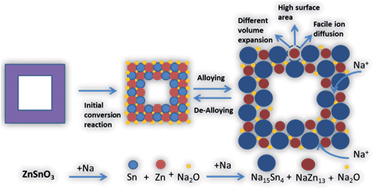Polycrystalline zinc stannate as an anode material for sodium-ion batteries†
Abstract
In this work, we report for the first time the electrochemical performance of polycrystalline ZnSnO3 as an anode material for sodium ion batteries (NIBs). The as-synthesized cubes were found to be derived from the self-assembly of ZnSnO3 nanoparticles. A hollow interior was subsequently obtained through a facile etching reaction. A reversible capacity of 315 mA h g−1 (∼0.3 V vs. Na+/Na) was obtained when cycled between 0.01 and 3.00 V vs. Na+/Na at 30 mA g−1. A decent capacity retention of 92% was also observed after 100 cycles when tested at 250 mA g−1. The ZnSnO3 hollow cubes were found to demonstrate superior electrochemical performance when compared with both ZnSnO3 solid cubes and manually blended ZnO–SnO2. The enhanced performance is believed to be attributed to the even distribution of Zn and Sn metallic nanoparticles following the first conversion process, which, conversely, is unachievable in manually blended ZnO–SnO2. Additional free space owing to different volume expansions during alloying of Zn and Sn easily permits diffusion of Na+ to the interior of the microcube, giving rise to enhanced capacity and cyclability.


 Please wait while we load your content...
Please wait while we load your content...